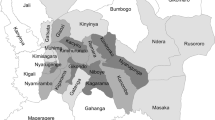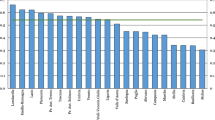Abstract
The territorial dimension of the digital divide is usually considered as a phenomenon that penalizes the peripheral regions, especially in terms of regional economic development. Taking into account the territorial networking of ICT (Information & Communication Technologies) infrastructures—particularly high-speed networks—provides what is probably the principal reason for such a perception. This is particularly true considering that the most-peripheral regions and those with the smallest population densities are also the poorest in terms of ICT infrastructures. In Western countries, however, the digital divide is no longer the result of network-related problems. Nowadays, the issue of the skills required to adequately exploit the potential of ICT is at the forefront. Yet this evolution is likely to lead to an inversion of the inequalities between the centre and the periphery, as populations without such skills—recent immigrants, the unemployed, the illiterate, people with little education or on low incomes and other socially marginalized people—are generally concentrated in urban centres. Consequently, the priority for reducing inequalities of access to ICT resources is no longer the provision of high-performance ICT infrastructures for peripheral regions, but rather the implementation of continuing education and social action policies within the urban centres.






Similar content being viewed by others
Notes
Vodoz/Rey/Rossel et al., La fracture numérique: émergence, évolution, enjeux et perspectives (2003–2005). In addition to theoretical work, this research included empirical phases, with some 80 qualitative interviews (of the semi-directive type) performed.
By ‘digital’ integration, we mean the appropriation of ICT and their resources by individuals or social groups, or in other words the ability to access digital technologies, to make concrete use of these technologies and to exploit their resources, but also the sense of integration which, subjectively, individuals develop in relation to the ‘world of ICT’.
We have represented the concept of social integration in the form of four dimensions of the social bond: the professional (employment), interpersonal (relations with the family, friends, etc.), political (the civil bond and participation in public life), and territorial (feeling of spatial belonging, associated in particular with a place of residence).
The notion of ‘periphery’ is the subject of major, recurrent debates. Within the framework of this article, we adopt the definition of Schuler et al. (2004) of the rural space as a synonym for ‘periphery’: '(…) the rural space is defined pragmatically as the sum of the regions which do not form part of an agglomeration, in the knowledge that these so-called rural regions present very different characteristics', agglomerations being defined as '(…) urbanised sites which are distinguished by a spatial concentration of the population and the economy. Unlike the [peripheral] regions, the centre and the neighbouring municipalities form an uninterrupted built totality' (ASPAN 1997). We further underline that we are at the level of the national territory here, not at the urban or metropolitan level: in our definition, the suburbs of agglomerations (areas of peri-urbanization) therefore form part of the so-called ‘central’ territories.
The universal service aims to ensure a minimum level of public services throughout the national territory, regardless of whether a location is peripheral or not.
Usually, a service may be considered as a minimum standard once more than 60% of households use it. The Federal Office of Communications will redefine the universal service provisions in the course of the forthcoming negotiations with Swisscom in 2007; ADSL may then form part of the universal service in Switzerland.
It should be noted here that the peripheral character of a region in terms of ICT does not—or does not necessarily—correspond to the peripheral character of a region from a territorial point of view. More generally, the peripheral character of a region in ICT terms is clearly linked to the territorial networking of ICT infrastructures; however, the hierarchical organization of ICT networks is not always superimposed on that of other infrastructure networks, nor on the spatial hierarchy of residential or urban environments.
The width of each of the trapezoids represents the degree of accessibility of the infrastructures (or the level of skills respectively): according to this Fig. 3, the more peripheral the territory, the lower the accessibility (or the level of skills respectively)
Socially decisive in the sense that they are indispensable to cover the primary basic needs in terms of access to information and online communication. It should be noted that taking into account computer entertainment would update or even reverse this postulate.
The ‘tertiarization' of industry, moreover, merely reinforces this phenomenon (Crevoisier and Maillat 1995). In another context, a study conducted in Switzerland on the liberalization of public services (Thierstein et al. 2004) highlighted the particular importance of telecommunications as a factor in the competitiveness of businesses located in the peripheral regions of the Alps. For these, what is important in this area is not so much the cost but rather the quality and performance of this type of service. Quite clearly, there is evidence of increased demand for high-speed infrastructures in businesses located at the periphery.
Regarding the distinction between the static and dynamic dimensions of the digital divide, see the next section.
With regard to social integration, the subjective dimension of integration or exclusion is as important as its objectification through indicators or ‘expert’ analyses.
In Switzerland, Internet use varies widely according to the level of education: 77.4% among those who have had a university education, 67.5% among those with higher vocational education, 44.0% among those with secondary education and 25.4% among those with compulsory education (OFS 2003). The data for France are similar, with Internet access rates varying between 10.1% for people with no qualifications and 57.6% for higher-education graduates; or, according to professional categories, access rates varying from 23.0% among industrial workers to 67.5% among managers (INSEE 2004).
See note 9. The rectangle in Fig. 5 then represents equivalent accessibility in urban and peripheral territories.
Note again that we consider the peri-urbanization areas as part of the ‘central’ territories. The Swiss Federal Office for Spatial Development, moreover, specifies that 'the socially disadvantaged population groups (…) tend to gravitate to the town centers, where they find greater anonymity, contacts and various social services. The town centers thus tend to concentrate social problems. In the large agglomerations, the trend towards impoverishment is not limited to the town center but also affects some municipalities of the close periphery' (ODT-ARE 2005).
See notes 9 and 16.
References
ASPAN [Association Suisse Pour L’aménagement National]. (1997). Lexique de l’aménagement du territoire. Berne: ASPAN.
C.E.A.T., LEM. (2004). La fracture numérique: état de la question et stratégie de recherche. Lausanne: C.E.A.T. [premier rapport intermédiaire; FNS, PNR 51].
Côté, S. (1999). Les NTIC et le développement des régions: une réflexion à poursuivre. The Canadian Geographer/Le Géographe Canadien, 3(2), 126–133.
Crevoisier, O., & Maillat, D. (1995). Quel développement pour l’Arc jurassien? Neuchâtel: EDES.
Crivelli, R. (2001). L’espace, lest du temps. In L. Vodoz (Ed.), NTIC et territories (pp. 77–86). Lausanne: PPUR.
Cunha, A., Leresche, J. -Ph., & Vez, I. (1998). Pauvreté urbaine – le lien et les lieux. Lausanne: Réalités sociales.
Ecoplan. (2004). Répartition de la richesse en Suisse. Rapport en réponse au postulat Fehr du 9 mai 2001 (01.3246). Ecoplan, Berne.
Gerster, R., & Haag, A. (2003). Diminishing the digital divide in Switzerland. Berne: DDC.
Girod, R., (1992). Modernité et illettrisme. Lausanne: Réalités sociales.
INSEE [Institut National de la Statistique et des Etudes Economiques]. (2004). Taux d’accès à Internet en France. http://www.insee.fr/fr/ffc/Ipweb/2005/ip1011/tableaux5.htm.
ODT-ARE [Office fédéral du développement territorial]. (2005). Rapport 2005 sur le développement territorial. Berne, ODT-ARE.
OFCOM [Office fédéral de la communication]. (2004). Communiqué de presse du 26 juillet 2004. http://www.bakom.ch.
OFFT [Office fédéral de la formation professionnelle et de la technologie]. (2004). Le fossé numérique en Suisse. Rapport à l’intention du Conseil fédéral. OFFT, Berne.
OFS [Office fédéral de la statistique]. (1993a). Carte thématique – Ampleur des problèmes sociaux au niveau communal. http://www.bfs.admin.ch/bfs/portal/fr/index/regionen/thematische_karten.html.
OFS [Office fédéral de la statistique]. (1993b). Carte thématique – Bénéficiaires de l’aide sociale communale. http://www.bfs.admin.ch/bfs/portal/fr/index/regionen/thematische_karten.html.
OFS [Office fédéral de la statistique]. (2000). Carte thématique – Taux de chômage dans les districts. http://www.bfs.admin.ch/bfs/portal/fr/index/regionen/thematische_karten.html.
OFS [Office fédéral de la statistique]. (2003). Indicateurs de la société de l’information. http://www.statistik.admin.ch/stat_ch/ber20/.
Pippa, N. (2001). Digital divide––civic engagement, information poverty and the internet worldwide. Cambridge (UK): Cambridge University Press.
Rallet, A. (1993). Les télécommunications: un facteur clé du développement régional? Revue d’économie régionale et urbaine, 1, 97–120.
Schuler, M., Perlik, M., & Pasche, N. (2004). Non-urbain, campagne ou périphérie – où se trouve l’espace rural aujourd’hui? Berne: ODT-ARE [Office fédéral du développement territorial].
Seydtaghia , A. (2004). Privées d’accès à l’ADSL, des dizaines de communes tentent de faire plier Swisscom, Le Temps [1er juin 2004, p. 17; entretien avec Adrian Bult, directeur de Swisscom Fixnet].
Thierstein, A., Abegg, Ch., Rey, M., Pfister Giauque, B., Natrup, W., & Thoma, M. (2004). Liberalisierung öffentlicher Dienstleistungen. Auswirkungen auf die Wettbewerbsfähigkeit der Unternehmen in Schweizer Berggebiet. Bern, Stuttgart, Wien: Haupt Verlag.
Vodoz, L. (Ed.). (2001). NTIC et territoires, Enjeux territoriaux des nouvelles technologies de l’information et de la communication. Lausanne: PPUR.
Vodoz, L. et al. (2005). Ordinateur et précarité au quotidien: les logiques d’integration provisoire de la formation continue. C.E.A.T. [Rapport final; FNS, PNR 51; 202 p.; disponible sur http://ceat.epfl.ch], Lausanne.
Vodoz, L., & Pfister Giauque, B. (2003). La dimension territoriale de la fracture numérique, In Actes du XXXIXème Colloque de l’ASRDLF. Lyon: Association de Science Régionale De Langue Française.
Vodoz, L., & Reinhard M. (2006). TIC et intégration sociale: les souris des villes dépassées par les souris des champs. Terminal No 95–96, L’Harmattan, Paris.
Author information
Authors and Affiliations
Corresponding author
Additional information
This article takes up and refines the argument developed in Vodoz and Reinhard 2006.
Rights and permissions
About this article
Cite this article
Vodoz, L., Reinhard, M. & Pfister Giauque, B. The farmer, the worker and the MP. GeoJournal 68, 83–92 (2007). https://doi.org/10.1007/s10708-007-9055-2
Published:
Issue Date:
DOI: https://doi.org/10.1007/s10708-007-9055-2




